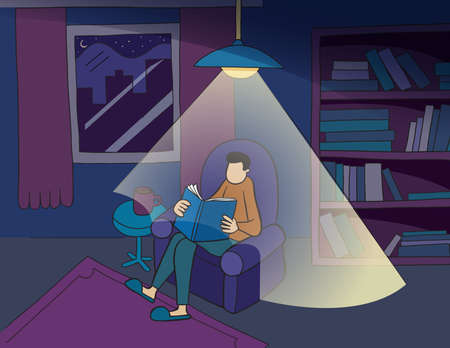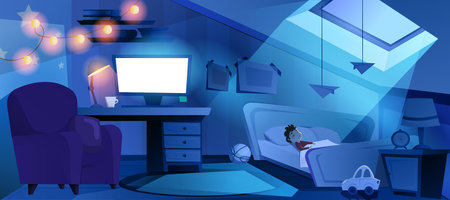The Science Behind Circadian Rhythms and Sleep
If you’ve ever felt groggy after staying up too late or noticed how bright mornings make it easier to wake up, you’ve experienced your circadian rhythm in action. Circadian rhythms are natural, internal processes that follow a roughly 24-hour cycle and help regulate your sleep-wake schedule. These rhythms are influenced by environmental cues—especially light—which signal to your brain when it’s time to feel alert or get ready for rest. In the United States, where busy lifestyles and screen time often disrupt our natural sleep patterns, understanding and supporting healthy circadian rhythms is more important than ever. When your sleep-wake cycle is in sync with these rhythms, you’ll fall asleep easier, wake up feeling refreshed, and improve your overall well-being. Disruptions, on the other hand, can lead to poor sleep quality, lower productivity, and even long-term health issues. That’s why finding ways to naturally support your body’s internal clock has become a growing focus for Americans looking to optimize their health—and why smart lighting could play a crucial role.
2. What Is Smart Lighting?
Smart lighting refers to advanced lighting systems that can be controlled remotely, automated based on your preferences, and even respond to environmental cues. Unlike traditional lighting solutions, which typically involve a simple on/off switch and limited customization, smart lighting offers a new level of convenience and personalization. These systems often connect to your home Wi-Fi network, allowing you to manage them using smartphones, voice assistants like Amazon Alexa or Google Assistant, or even scheduled routines.
In the United States, popular smart lighting products include brands like Philips Hue, LIFX, Sengled, and GE Cync. These products offer features such as adjustable color temperature, dimming options, and integration with smart home ecosystems. For example, you can set your lights to gradually brighten in the morning to mimic a sunrise or shift to warmer hues in the evening to help signal your body that it’s time to wind down for sleep.
Key Differences Between Smart Lighting and Traditional Lighting
| Feature | Smart Lighting | Traditional Lighting |
|---|---|---|
| Control Options | App, voice commands, automation | Manual switches only |
| Color Adjustment | Customizable (cool/warm tones) | Fixed color temperature |
| Integration | Works with other smart devices | No integration capabilities |
| Scheduling & Automation | Programmable routines & timers | No automation features |
| Impact on Sleep & Circadian Rhythm | Can support healthy sleep patterns by adjusting light exposure throughout the day | No impact; constant light output regardless of time of day |
The flexibility and intelligence of smart lighting make it especially effective for optimizing your environment in support of healthy sleep habits and circadian rhythm alignment—something traditional bulbs simply can’t match.

3. How Light Influences Your Sleep
Light plays a powerful role in regulating your sleep and circadian rhythm, especially through its impact on melatonin production. Melatonin is a hormone produced by the pineal gland that signals your body when its time to wind down and prepare for sleep. Exposure to bright light, particularly blue light from screens or overhead lighting in the evening, can suppress melatonin release, making it harder to fall asleep at night. On the other hand, getting plenty of natural light during the day helps boost alertness and keeps your internal clock on track.
The timing, intensity, and color temperature of the light you’re exposed to can significantly influence your sleep patterns. For example, exposure to cool, blue-toned light in the morning helps signal to your brain that it’s time to wake up and be alert. In contrast, warmer, dimmer lighting in the evening supports relaxation and lets your body know bedtime is approaching. This is where smart lighting comes into play: by automatically adjusting brightness and color throughout the day and evening, these systems can help reinforce healthy sleep-wake cycles and support better overall rest.
4. Benefits of Smart Lighting for Better Sleep
Smart lighting systems are transforming the way Americans approach sleep and overall wellness by supporting healthy circadian rhythms. These advanced systems do more than just brighten or dim a room—they can mimic natural light patterns, which helps signal to your body when it’s time to wake up or wind down. This synchronization with natural daylight is crucial for regulating the body’s internal clock, also known as the circadian rhythm.
How Smart Lighting Regulates Circadian Rhythms
The human body responds to changes in light throughout the day. Smart lights can automatically adjust their color temperature and brightness based on the time of day, providing cool, bright light in the morning to boost alertness and warm, dimmer tones in the evening to promote relaxation and melatonin production. For example, many American families use smart bulbs in bedrooms and living rooms that gradually shift from energizing white light during breakfast hours to soothing amber hues after dinner.
Promoting Restful Sleep
Smart lighting is especially beneficial for individuals who struggle with falling asleep or waking up at consistent times—common issues given America’s busy lifestyles and frequent exposure to screens late at night. By setting up smart lights to dim automatically an hour before bedtime, users can cue their bodies for rest without even thinking about it. Some smart lighting systems also include features like “night mode,” where lights turn off blue wavelengths that can otherwise disrupt sleep quality.
Practical Examples in American Homes
| Scenario | Smart Lighting Solution | Benefit |
|---|---|---|
| Evening Routine for Kids | Lights transition to soft yellow at 7 PM | Helps children wind down and get ready for bed earlier |
| Shift Workers or Night Owls | Custom schedules simulate sunrise/sunset indoors | Improves sleep consistency despite irregular work hours |
| Mornings in Winter Months | Bright, cool-toned wake-up lights | Eases morning grogginess during dark winter mornings |
| Late-Night Screen Time | Lamps shift to red spectrum after 10 PM | Reduces blue light exposure, aiding faster sleep onset |
Overall Improvements in Sleep Quality
The flexibility of smart lighting means that every household can personalize their setup to fit unique routines and preferences. Whether it’s setting bedroom lights to fade out gently or using voice assistants to control lighting hands-free, these systems offer a practical solution for improving sleep hygiene. As more Americans become aware of the link between light exposure and sleep health, smart lighting is quickly becoming a staple for better rest and energized mornings.
5. Tips for Using Smart Lighting to Improve Sleep
Set Up a Consistent Lighting Schedule
One of the most effective ways to use smart lighting for better sleep is to program your lights to follow a consistent schedule. Start by setting your bedroom and living spaces to gradually dim in the evening, ideally starting about an hour before your usual bedtime. Many Americans find that using their smart home app or device, such as Alexa or Google Home, makes this process seamless. For example, you can say, “Alexa, turn on bedtime mode,” and have your lights automatically shift to a warmer, softer tone that cues your body it’s time to wind down.
Choose the Right Color Temperature
Smart bulbs often let you adjust both brightness and color temperature. In the evenings, opt for warmer tones (around 2700K), which mimic sunset and signal to your brain that it’s time to produce melatonin. In the morning, schedule your lights to brighten with cooler, daylight-like tones (5000K-6500K) to help you wake up naturally and boost alertness.
Integrate With Your Smart Home Ecosystem
Leverage the power of home assistants like Google Home or Amazon Alexa by creating routines that sync lighting changes with other activities. For instance, you can set up a “Good Night” routine that not only dims the lights but also lowers the thermostat and plays calming music. These automations make healthy sleep habits easier to stick with and are especially helpful for busy American families juggling hectic schedules.
Recommended Smart Lighting Settings
- Evening: Dim lights below 30% brightness and switch to amber or red hues at least one hour before bed.
- Morning: Gradually increase brightness starting 15-30 minutes before your alarm goes off using daylight-mimicking colors.
- Nighttime: Use motion-activated low-level nightlights in hallways or bathrooms to avoid harsh light exposure if you wake up overnight.
Keep It Simple
If you’re new to smart lighting, start small—just automate your bedroom lights first and build from there. With user-friendly apps and voice commands, even tech beginners can benefit from these simple changes. Over time, you’ll notice improved sleep quality as your lighting supports healthier circadian rhythms.
6. Choosing the Right Smart Lighting Solution
Selecting the best smart lighting system for your sleep and circadian rhythm involves considering your individual needs, budget, and the compatibility of devices with your home setup. With so many options available in the U.S. market, it’s important to find a solution that not only supports your wellness goals but also fits seamlessly into your lifestyle.
Identify Your Lighting Goals
Start by asking yourself what you want to achieve with smart lighting. If improving sleep is your main focus, look for bulbs and systems that offer adjustable color temperatures, dimming features, and scheduling capabilities. Products with “circadian” or “sleep mode” settings can help automate healthy lighting changes throughout the day and night.
Budget Considerations
Smart lighting solutions range from affordable single-bulb options to comprehensive whole-home systems. Entry-level products like smart bulbs from Wyze or Sengled are perfect for those on a tight budget, while premium systems from brands like Philips Hue or LIFX offer advanced features such as voice integration and customizable routines. Don’t forget to factor in the cost of additional accessories like hubs or switches if needed.
Check Compatibility
Before purchasing, ensure that your chosen smart lighting works with your existing devices. Most popular brands in the U.S., such as Philips Hue, LIFX, GE Cync, and TP-Link Kasa, are compatible with major platforms like Amazon Alexa, Google Assistant, and Apple HomeKit. Compatibility will allow you to control lights using your preferred smart speaker or smartphone app.
Popular Retailers for Smart Lighting
You can find a wide selection of smart lighting products at retailers like Best Buy, Home Depot, Lowe’s, Target, and Amazon. These stores often provide helpful comparison tools and customer reviews to guide your decision-making process.
Making the Right Choice
Ultimately, the best smart lighting solution is one that matches both your health needs and your household’s tech ecosystem. Take time to research product features, read user feedback, and consider how each option will support healthier sleep patterns through better circadian rhythm management. By investing in the right system, you’ll be well on your way to creating a more restful and revitalizing home environment.

